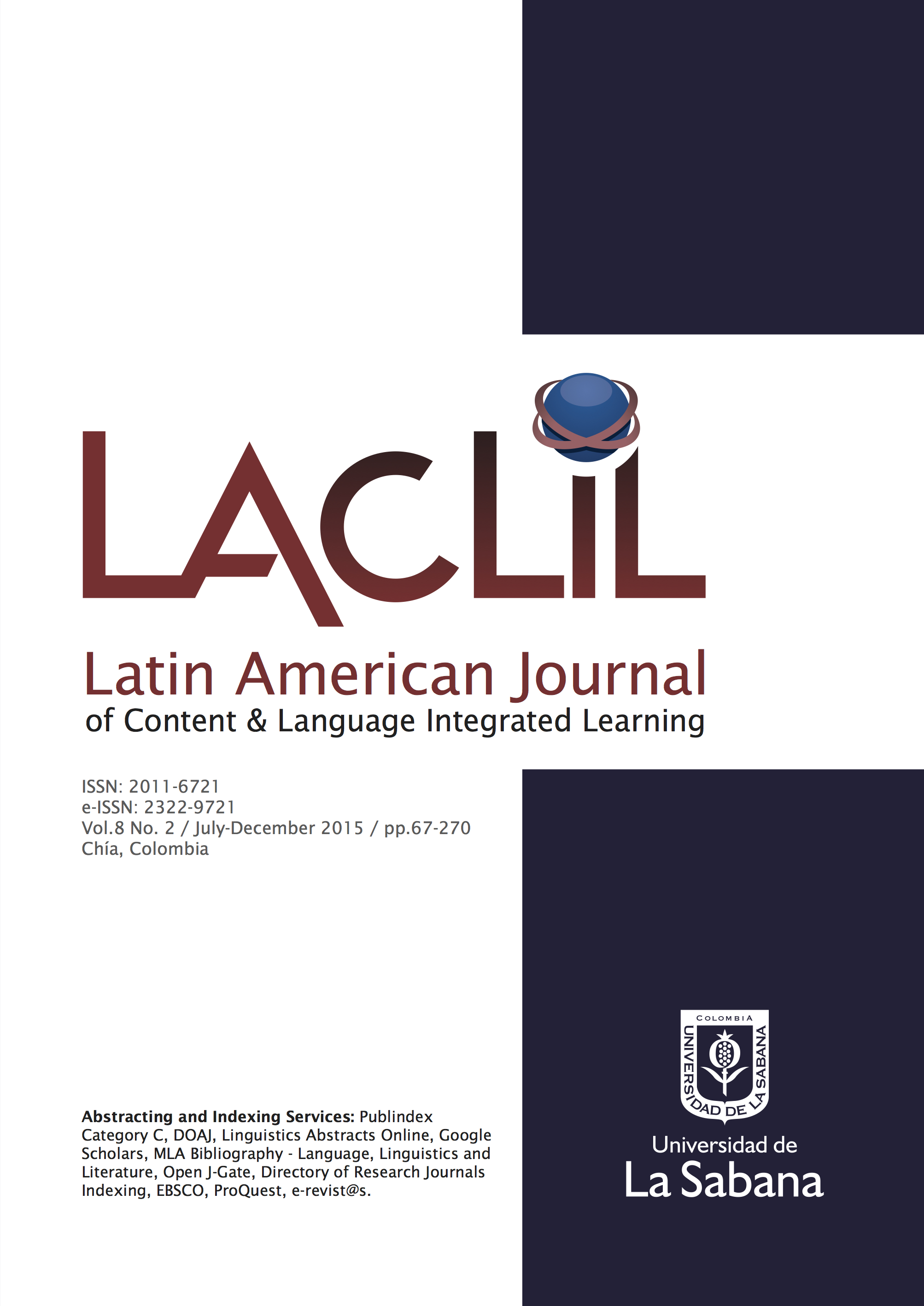The dialogues between content and language: Cautions and challenges in the emergence of a bilingual education program
DOI:
https://doi.org/10.5294/5917Keywords:
AICLE (aprendizaje integrado de contenidos y lenguas extranjeras), CBI (instrucción basada en contenidos), SIOP (protocolo de observación de instrucción amparada), ciencias naturales, interdisciplinariedad.Abstract
This paper presents a set of ideas about the basics for developing interdisciplinary dialogues between content (science) and language (English) in bilingual educational processes, under the premise that a satisfactory relationship between those elements help guarantee successful content-based instruction (CBI) in its form known as sheltered instruction. Additionally, a practical example (based on a science curriculum) is presented to demonstrate some principles that inform approaches to teaching such content. Finally, based on the authors’ interdisciplinary work and pedagogical experiences, some recommendations on teaching content and language in bilingual settings are presented in the form of cautions (a balance of actions) and challenges (prospects).
Downloads
References
Aguilar, C. & Alzate, N. (2015). La construcción del programa de educación bilingüe del LHEMI La Salle: Un itineario para la convergencia entre contenido y lengua extranjera. In N. A. Murcia Suárez (Ed.), Sistematización de experiencias educativas en la escuela lasallista Nº2 (pp. 251-273). Bogotá, Colombia: Distrito Lasallista de Bogotá. Retreived from http://www.lasalle.org.co/wp-content/uploads/2015/03/Libro_sistematización_experiencias_No2_web.pdf
Brinton, D. M., Snow, M. A., & Wesche, M. B. (1989). Content-based second language instruction. New York, NY: Newbury House.
Cummins, J. (2000). Language, power and pedagogy: Bilingual children in the crossfire. Clevedon, UK: Multilingual Matters.
Echavarría, J., Vogt, M., & Short, D. (2013). Making content comprehensible for English learners: The SIOP Model (2nd ed). Upper Saddle River, NJ: Pearson.
García Ruíz, A. & Castro Guío, M. D. (2005). Aplicación del enfoque ciencia, tecnología, sociedad y ambiente ante problemas reales: Vertidos incontrolados de residuos. Enseñanza de las ciencias, Numero extra. Retreived from http://ddd.uab.cat/record/69217?ln=ca
Huber, G. L. (2008). Aprendizaje activo y metodologías educativas. Revista de Educación, Número extraordinario, 59-81. Retrieved from http://www.revistaeducacion.mec.es/re2008_04.htm
Hammond, L. (2012). Teaching science. In L. Ferlazzo & K. Sypnieski (Eds.), The ESL/ELL teacher’s survival guide: Ready-to-use strategies, tools, and activities for teaching English language learners of all levels (pp. 223-228). San Francisco, CA: Jossey-Bass.
Johnstone, A. (2006). Chemical education research in Glasgow in perspective. Chemistry Education Research and Practice, 7(2), 49-63. http://dx.doi.org/10.1039/B5RP90021B
Liceo Hermano Miguel La Salle (2013). Política de bilingüismo 2013. Bogotá, Colombia: Liceo Hermano Miguel La Salle.
Mora, W. & Parga, D. (2007). Tramas histórico-epistemológicas en la evolución de la teoría estructural en química orgánica. Tecné, Epísteme y Didaxis, 21, 100-118.
Morin, E. (1999a). La cabeza bien puesta: Repensar la reforma, reformar el pensamiento. Buenos Aires, Argentina: Ediciones Nueva Visión.
Morin, E. (1999b). Relier les connaissances: Le défi du XXIe siècle. Paris, France: Éditions Seuil.
Nakamatsu, J. (2012). Reflexiones sobre la enseñanza de la química. Blanco y Negro, 3(2), 38-46.
Rodríguez, M. (2012). Una evaluación curricular del programa de educación bilingüe en el Liceo Hermano Miguel La Salle. Bogotá, Colombia: LHEMI La Salle.
Short, D., Vogt, M. E., & Echavarría, J. (2008). The SIOP model for administrators. Boston, MA: Pearson.
Shulman, L. (1987). Knowledge and teaching: Foundations of the new reform. Harvard Educational Review, 57(1), 1-22.
Sokoloff, D. & Thornton, R. (2004). Interactive lecture demonstrations. Hoboken, NJ: Wiley & Sons.
Stryker, S. B. & Leaver, B. L. (1997). Content based instruction in foreign language education: Models and methods. Washington, DC: Georgetown University Press.
Truscott de Mejía, A.-M., López Mendoza, A. A., & Peña Dix, B. (2011). Bilingüismo en el contexto colombiano: Iniciativas y perspectivas en el siglo XXI. Bogotá, Colombia: Ediciones Uniandes.
Downloads
Published
How to Cite
Issue
Section
License
This Journal and its articles are published under the Creative Commons CC BY 4.0 DEED Attribution 4.0 International license. You are free to: Share — copy and redistribute the material in any medium or format for any purpose, even commercially. Adapt — remix, transform, and build upon the material for any purpose, even commercially. The license cannot revoke these freedoms as long as you follow the terms of the license.








